First lessons...
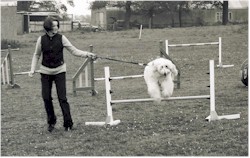 There
is a big difference between teaching 'new' beginner handlers and their dogs compared to
teaching experienced handlers with 'new' dogs. Experienced handlers know what to expect and may
have done some of the basics while their puppy was growing up. New handlers and their dogs come
with a blank sheet. While it's exciting and challenging to teach them, it is also a big
responsibility. As their trainer, you are going to mould them into the agility handlers of the
future. It is important to remember these are all individuals and what works for you and your
dog may not work with them. Alison Renwick says that being out in front all of the time can be
tough but rewarding. There
is a big difference between teaching 'new' beginner handlers and their dogs compared to
teaching experienced handlers with 'new' dogs. Experienced handlers know what to expect and may
have done some of the basics while their puppy was growing up. New handlers and their dogs come
with a blank sheet. While it's exciting and challenging to teach them, it is also a big
responsibility. As their trainer, you are going to mould them into the agility handlers of the
future. It is important to remember these are all individuals and what works for you and your
dog may not work with them. Alison Renwick says that being out in front all of the time can be
tough but rewarding.
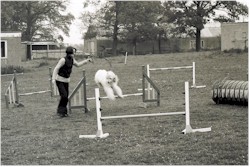 Encouraging
new handlers to come and watch other classes of more experienced dogs is often beneficial so
they get an idea of what agility is all about. It is also very beneficial to have all the
handlers come the week before the course begins and go through the equipment and give them a
list of suggested commands to think about before they begin. This should hopefully stop that
awkward silence by the first jump when they try and decide whether this will be a Ďjumpí an
Ďupí or an Ďoverí! You can also go through suitable footwear and clothing to wear, toys and
titbits to bring and that dogs should only train in flat collars and leads and not check
chains, harnesses, flexi leads etc. These are not necessarily obvious to a complete beginner. Encouraging
new handlers to come and watch other classes of more experienced dogs is often beneficial so
they get an idea of what agility is all about. It is also very beneficial to have all the
handlers come the week before the course begins and go through the equipment and give them a
list of suggested commands to think about before they begin. This should hopefully stop that
awkward silence by the first jump when they try and decide whether this will be a Ďjumpí an
Ďupí or an Ďoverí! You can also go through suitable footwear and clothing to wear, toys and
titbits to bring and that dogs should only train in flat collars and leads and not check
chains, harnesses, flexi leads etc. These are not necessarily obvious to a complete beginner.
The most
important things to remember
Once the course has started the most important thing about a first lesson is that at the end of
the class both handler and dog feel they have achieved something. Feeling successful at the
beginning will motivate them to continue and to work through all the problem times that
undoubtedly lie ahead. The success can be very small and is often varied within a new class.
Some dogs are capable of completing a row of three or four 15-inch jumps in their first lesson.
Other dogs can only cope with being recalled over a pole on the ground. Both handlers need to
go away feeling that they have achieved something though.
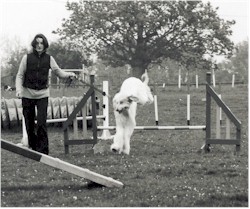 Another
very important point is always to have the handlers work their dog on the right and left from
the very beginning. This is especially important for handlers that have come from an obedience
background as they are programmed to work only on the left and often find it difficult to cope
with a dog on the right. Practising from the very beginning will hopefully ensure that by the
time the dog is able to handle sequences, so is the handler! Another
very important point is always to have the handlers work their dog on the right and left from
the very beginning. This is especially important for handlers that have come from an obedience
background as they are programmed to work only on the left and often find it difficult to cope
with a dog on the right. Practising from the very beginning will hopefully ensure that by the
time the dog is able to handle sequences, so is the handler!
Handling
skills - start as you mean to go on
In teaching new people as against only new dogs I think it is important to start introducing
handling skills early on so the human part of the team has enough time to learn them and not
cause frustration to the dog later. I find a distinct pattern occurs with newcomers to agility.
At the beginning the dog is very green and the handler feels in control and able to cope with
most things you introduce. Then you go through the phase where it all begins to click in the
dogís brain Ė oh thatís what you wanted Ė and the dog beings to take over and suddenly the
handler has to rush to catch up. They suddenly find they have to think about where they should
be, what hand signal, body language, voice command should be used and where the dog is all at
the same time and at double quick time!
This is the phase where the trainer has
to be very supportive, as a lot of new people can get very disillusioned at this stage. I often
find getting the handler to run a sequence without the dog a couple of times helps. We back
chain our dogs for optimum learning and sometimes we need to back chain our new handlers.
I always begin to discuss the bigger
picture of agility early on. This gives an understanding to beginner handlers as to why it is
important to practice each manoeuvre from the left, right, in front and behind. They need to
realise each sequence they come across could be part of a course, approached from any
direction. This gives some credence to the fact you are insisting they start with the dog on
one side or other when taken on its own it would be better to have the dog on the other side!
Introduce
contacts correctly from the beginning
Contacts are always a tough one to teach to new handlers if they are
totally new to the sport. I find it is very difficult for them to fully understand the
importance of getting and keeping good contacts. To teach contacts well I personally think back
chaining a stop at the bottom of the contact is imperative. This however takes time, patience
and consistency. Not always something a new handler has. They often want results much faster
than good solid contact training can give them. This is sometimes where establishing whether
the members of your class are likely to ever compete or just coming to classes each week to
have fun with their dogs is important. If there is a chance the handler may compete then I
carry on extolling the virtues of good contacts. Once a solid stop has been established I may
allow some of the bigger dogs to run down their contacts so long as they are still stopped on a
regular basis and show no signs of jumping off. There is a lot of stress on the joints for a
big dog to stop at the bottom of the A frame each time and as long as the stop is maintained I
donít feel it need be used every time.
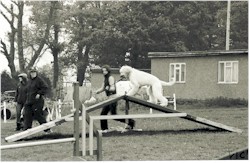 The
introduction of the see-saw is always a controversial issue. Some schools of thought state it
should be the last thing taught, I personally agree with those that teach it as one of the
first pieces of equipment introduced. Some of the reasons for this are that at the beginning
everything is generally a bit slower. The dog and handler are not trying to go full pelt over
things so more care is taken. Most importantly though, I think if you teach it later and the
dog has got confident over the dog walk and A frame and found they are solid and unmoving
pieces of equipment to suddenly say; ĎHey this one
movesí, is a bit unfair! The
introduction of the see-saw is always a controversial issue. Some schools of thought state it
should be the last thing taught, I personally agree with those that teach it as one of the
first pieces of equipment introduced. Some of the reasons for this are that at the beginning
everything is generally a bit slower. The dog and handler are not trying to go full pelt over
things so more care is taken. Most importantly though, I think if you teach it later and the
dog has got confident over the dog walk and A frame and found they are solid and unmoving
pieces of equipment to suddenly say; ĎHey this one
movesí, is a bit unfair!
By introducing the see-saw early you
have more time to get it right and build the dogís confidence while you are back chaining your
other contacts. By the time the dog is ready to do a full dog walk at speed it should be
confident on the seesaw and know the difference. The obviously important point to make to
handlers is that they have very different commands for the seesaw and the other contacts so the
dog knows word 'X' means it moves word 'Y' means it doesnít. I have introduced the seesaw first
in the last few beginner courses I have taught and noticed a big difference in the confidence
of the dogs over the seesaw by the end of each course.
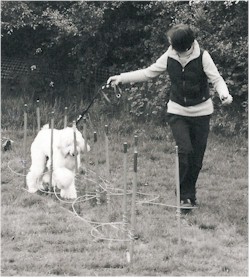 Training
dogs to weave Training
dogs to weave
Weaves are another piece of equipment with a variety of teaching methods available. I have
personally tried push and pull, channel weaves and V weaves with my own dogs over the years and
had the most success with channel weaves although I think it was the dog not the V weaves that
were the problem with the last one!!
I would not like to teach beginner
handlers the push and pull method. I am sure many people have had good success but I donít like
the stress the method often causes the dog. Most beginner handlers donít handle their dogs well
or recognise signs of stress and often the dogs in question are not used to be handled in the
sort of way you need to, to physically get a dog through a set of straight and solid weave
poles (especially big dogs). I also think it teaches slow performance from the beginning which
you then have to speed up. I prefer either the
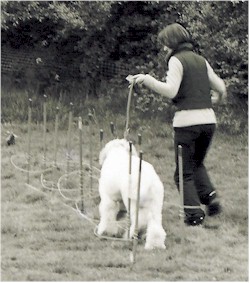 channel
or V weave method where speed and distance from the handler can be built up very quickly. With
the push and pull method a lot of dogs become reliant on the handler being close. With the
channel/V weave methods recalls and send always can be started very early on. channel
or V weave method where speed and distance from the handler can be built up very quickly. With
the push and pull method a lot of dogs become reliant on the handler being close. With the
channel/V weave methods recalls and send always can be started very early on.
One problem I have found with teaching the V weave method
in a class situation where dogs need different angles is the bolts tend to work lose and it is
difficult to maintain a firm position (and not practical to keep tightening the bolts each time
a dog goes through). Another problem is some big dogs (mine included) tend to use their weight
to push the poles out of the way which cannot be done with the more stable channel weaves.
Weaves are the most important piece of
equipment promising handlers should be encouraged to invest in as the benefits of practising a
little each day at home are huge.
Visual v.
verbal signals
Body language is a very important lesson to teach new handlers. Most
are unaware that dogs pick up on visual signals far more than voice commands. Get them thinking
about what their body position is telling their dog from the very beginning. Doing each
exercise left, right, in front and from behind is useful so they begin to understand how
important good body language is to the dog. I often have my classes run with body language only
and no voice commands and then do the same run keeping their arms tight to their bodies and
only using their voice. It is interesting to see the difference, body language counts for so
much and this clearly shows the importance. You also often find noisy dogs bark less when no
voice commands are used. They donít get into a shouting match with their handler.
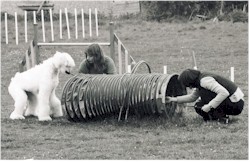 No
two dogs are the same No
two dogs are the same
As a trainer, it is important to get a feel for each dog and handler
in your class during the first few lessons. Every dog is individual and will progress at a
different rate and it is important to balance the lesson so each partnership feels they have
achieved something. Donít make it too easy for those that show ability or they will get
frustrated and donít make it too hard for those that are struggling Ė it should be fun for all.
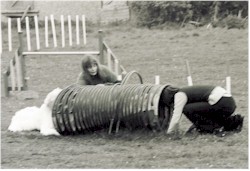 Be
aware of the different dog breeds within a class. To reward the majority of collies getting
them to do something again is very high on the agenda. This does not work with all dogs and
often you need to explain to handlers of other breeds that repetition of something will turn
their dog off. Do something different with them or advise them to call a halt to the lesson
early. Be aware of what the dog is showing. It is a fine balance between people feeling they
arenít getting their moneyís worth if you advise them to stop early and risking damaging the
attitude of some dogs if you donít. Not all dogs enjoy agility which, believe me, is very
frustrating for handlers that want to do well. Be
aware of the different dog breeds within a class. To reward the majority of collies getting
them to do something again is very high on the agenda. This does not work with all dogs and
often you need to explain to handlers of other breeds that repetition of something will turn
their dog off. Do something different with them or advise them to call a halt to the lesson
early. Be aware of what the dog is showing. It is a fine balance between people feeling they
arenít getting their moneyís worth if you advise them to stop early and risking damaging the
attitude of some dogs if you donít. Not all dogs enjoy agility which, believe me, is very
frustrating for handlers that want to do well.
Identifying and coping with
stress
As a trainer it is very important to learn to recognise stress and
calming signals given out by dogs in your class. The welfare of all the dogs is your
responsibility and an environment that is calm and as quiet as possible, will aid learning.
Dogs canít learn if they are stressed. You need to make handlers aware of their own dogís
behaviour and keep space between them. Remember, these are probably dogs that are not used to a
situation full of other excited dogs, they werenít socialised around the agility circuit and,
therefore, coming into an enclosed environment with maybe 10 potentially excited and noisy dogs
can be very stressful.
It is important to manage your class well, ensure space
is kept at the end of a sequence so a dog can finish its run without running into other dogs or
being stared at by them. This avoids aggressive confrontations and avoids the shy dogs baulking
at the last fence. Ensure when a dog sets off the rest of the class donít bark excitedly at the
movement. Managing these situations is better that trying to train the dogs to be quiet at this
stage. Training should be done in less challenging situations away from agility and to be
honest a lot of owners wonít want to be bothered to do this so removing the dogs that start
barking to a position they canít see the dog working has to be a good compromise.
Barking is one of those very personal
things. Some people are totally unworried by their dog barking Ė I personally hate it. I once
read the only way to stop a dog barking in agility was to never allow it to begin in the first
place and I do agree. Getting the handlers of noisy dogs to agree too is sometimes difficult
though. With the very hysterical types I do try and stop undesirable behaviour straight away. I
teach the dog it has to control itself and if it doesnít then it canít play (do agility). By
getting the handler to stop every time the dog hits that hysterical level, be it spinning,
barking or other frenzied behaviour you can generally get results quite quickly. These dogs are
generally quick to learn and soon work out what keeps the handler moving and the game going on.
Consistency is of course paramount and needs to be explained carefully to the handler.
Long term
goals and objectives
I think there is much more to teaching agility to beginners than just getting a dog to go over
a jump. If I can help handlers understand their dog a little more, know what stress and calming
signs to look out for, realise when they dip their shoulder in that direction they are giving a
visual signal to the dog, then I feel I have done a good job. I want the handlers in my class
to finish a course and maybe go on to compete in agility but most of all, I want them to have
fun with their dog, to continue to take classes which mentally and physically stimulate their
dog and to have enjoyed the experience.
|
Teaching weaves

Channel weaves are an excellent
method of teaching speed and non-reliance on the handler from an early stage. They can be
just as effective used without the wires as long as you start with the channel wide enough
and reward the dog for running straight through.

The space within the channel is
gradually reduced and the direction of entry is widened. Taught like this the dog learns
weaves are fun and fast to do right from the beginning which is invaluable with less
motivated dogs and doesnít curtail the enthusiasm of the motivated ones. |
Teaching tunnels

Learning new equipment can be quite stressful for a dog. Faced with a long
dark tunnel most dogs will shy away

It is important to recognise this stress and do everything to reduce it. Having the dog lie
down at one end and the handler make eye contact through the tunnel from the other will
help with big dogs in particular.
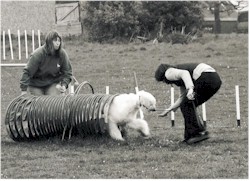
Reducing the length of the pipe tunnel will also make the
obstacle less intimidating for the dog. It is important to reward the dog as it emerges. As
confidence builds the handler can run with the dog remembering to work both left and right. |
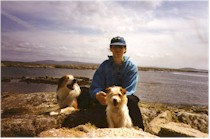 About
the author About
the author
Alison Renwick
started competing in agility in 1987 with Cali, a rough coated Jack Russell Terrier. She
qualified for the Pedigree Chum Mini Agility Stakes final at Olympia in 1988 and competed in
the 1989 invitation stakes. She also qualified for the Eukanuba finals at Crufts in 1992.
Ruari, a working sheepdog, joined the family in 1990 and went on to
qualify for the NCDL Starters final in 1993, Spillers Knock Out final in 1994 and the Vitapet
Veterans final in 1999.
Over the years Alison has been lucky to be able to borrow and train a
number of other dogs, which have been a very valuable practising ground.
In 1999 having lost Cali Alison took on the responsibility of
socialising a black Labrador for Hearing Dogs for Deaf People and is very proud to say this dog
has now passed her finals and gone on to help her disabled and deaf recipient enjoy a better
quality of life,
Always very interested in improving her knowledge on how dogs learn
and new ways of training, she qualified as an approved Agility Club instructor in 1998 and
thoroughly enjoys teaching new beginners.
Ever ready for a challenge she now has a Bouvier des Flandres called
Bruin, and is trying to convince her that agility is fun!
Alison recently moved to the South
Midlands with her husband Steve, Ruari, Bruin and a diabetic cat called Finnegan. She is a
Purchasing Manager for an infomercial company, and is lucky to work from home most of the time.
Credit: Doushman, the
Afghan owned by Maria Shaverneva and trained at Whirlwind Agility
Photos by Vic
From
Sally Adam, South African Dog Agility Association
May we use the article 'Teaching Newbies' on our agility organisation's site? I'm just starting
up a training page and it's an excellent article. Many thanks
http://www.sadaa.co.za
|  About
the author
About
the author